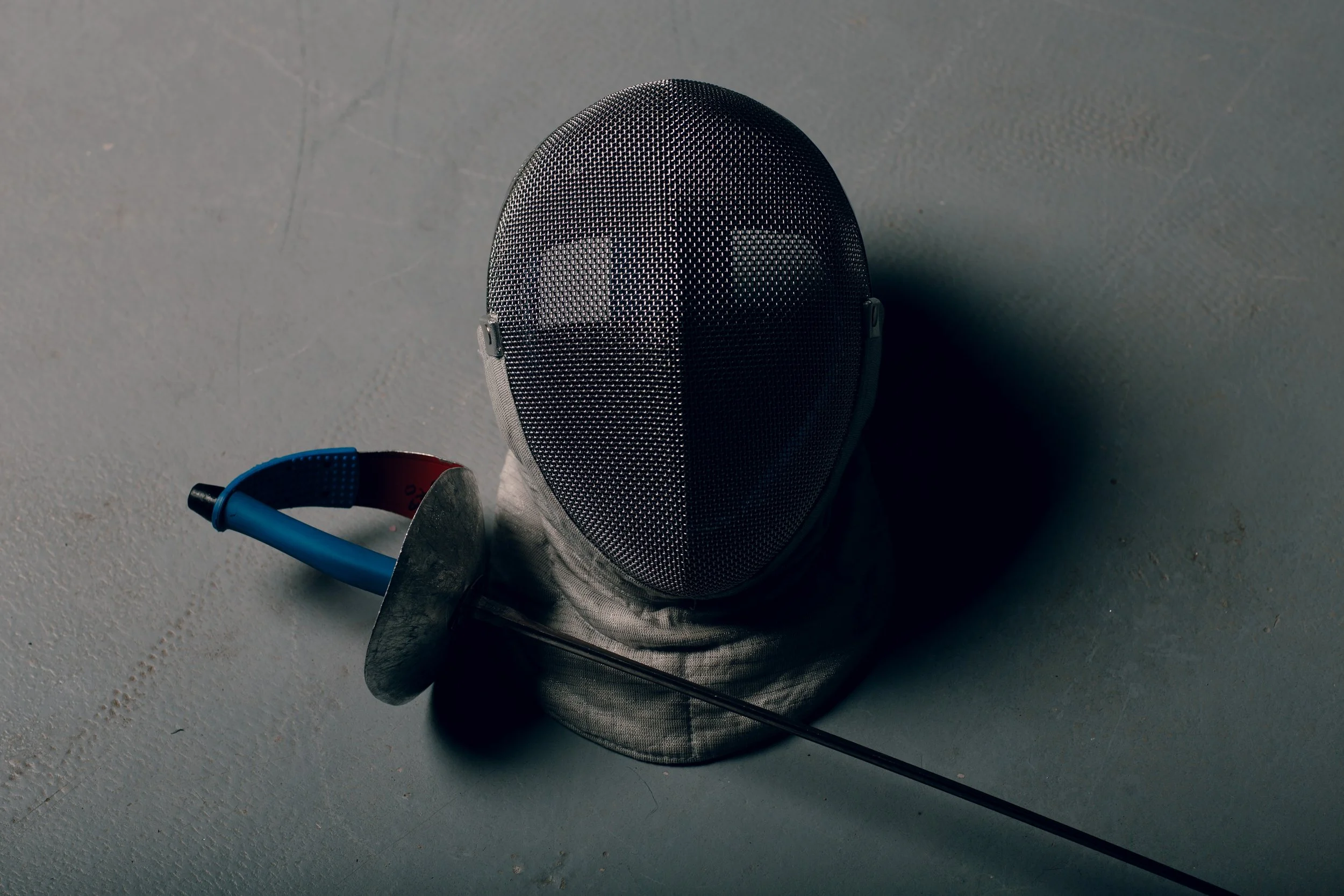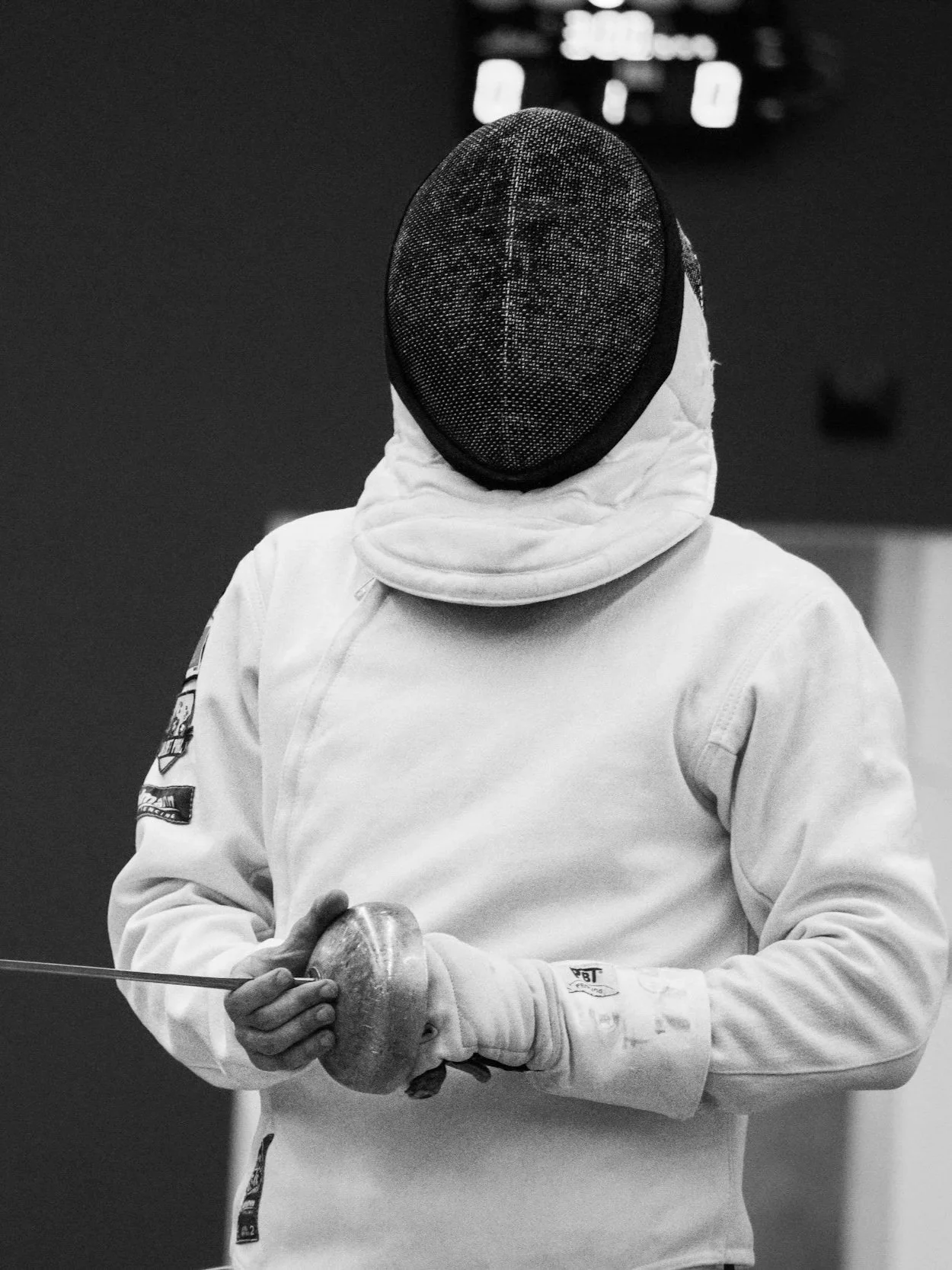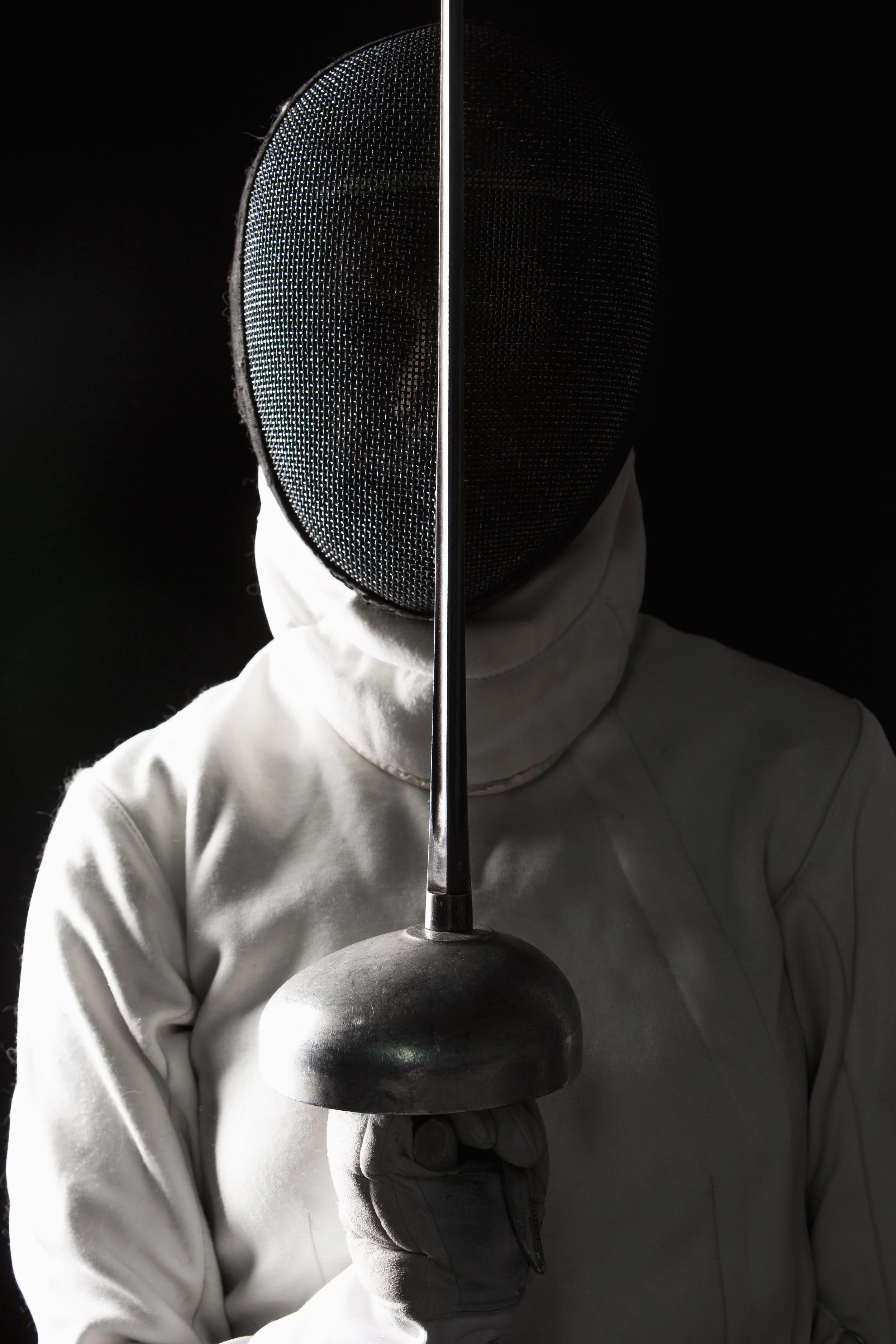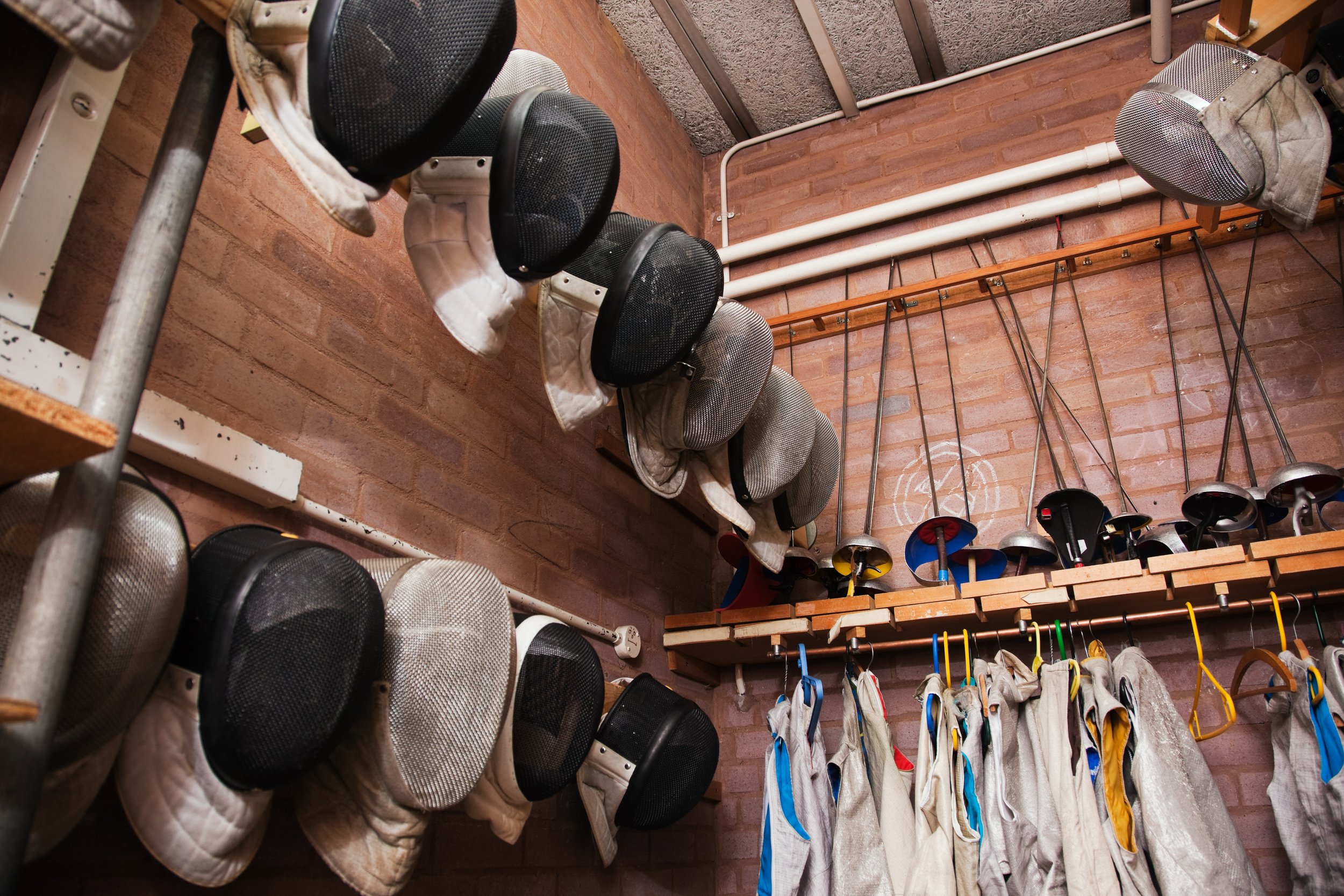
TOURNAMENT PREPARATION: The Mind
Mentally Prepare to Out-think Every Opponent’s Strategy
Prime Focus & Attentional Control
Why it matters:
Fencing demands dynamic attention switching — widening awareness to track distance and opponent cues, then narrowing focus in milliseconds to execute a precise action. Neuroscience shows this flexibility relies heavily on the prefrontal cortex, which tires easily under stress, fatigue, or distraction. If left unmanaged, athletes fall into “attentional traps” (fixating on mistakes, overthinking, or ignoring critical cues).
-
Don’t just imagine actions—add sensory layers.
Visual: the strip, the referee’s signal, the opponent’s stance.
Auditory: footfalls, clash of blades, referee calls.
Kinesthetic: weight shift in the lunge, grip pressure, breath rhythm.
This recruits multiple neural networks, creating stronger “mental reps” that mimic real competition.
-
Use one short cue to “open” attention (e.g., “see space”), and another to “narrow” it (e.g., “point first”).
Practice toggling between these in training so it becomes automatic under pressure.
Research shows concise, external cues reduce reaction time and improve motor execution.
-
Choose a neutral anchor (the strip line, the bell guard, even your breath).
Between touches, glance or breathe with your anchor to reset attention.
This prevents “carryover distraction” — the mind staying stuck on the last point.
-
Spend 3–5 minutes daily observing your breath or body sensations.
Each time your mind wanders, gently return—this is attentional weight training.
Studies show just two weeks of consistent practice improves sustained focus and reduces stress reactivity.
-
One deep breath in, slow exhale out.
Repeat cue word (“light feet”).
Visualize the first exchange.
Step onto strip with focus already locked.
Why it works:
These tools keep the prefrontal cortex from being hijacked by nerves or fatigue, freeing cognitive bandwidth for tactical decision-making. A fencer who can control their attentional spotlight—when to widen, when to narrow—will consistently outpace an opponent whose focus is scattered or stuck.
Why it matters:
Tournament nerves are real. When the body perceives pressure, the nervous system triggers a fight-or-flight response: elevated heart rate, shallow breathing, muscle tension, and racing thoughts. A little activation is useful—it sharpens reflexes and focus—but too much leads to tight fencing, rushed decisions, and wasted energy. On the other side, if energy is too low, reactions slow and execution feels heavy. The best competitors learn to find their middle ground, balancing calm with intensity.
-
Box Breathing: Inhale 4, hold 4, exhale 4, hold 4—ideal for calming nerves the night before or in the morning.
Extended Exhale Breathing: Inhale 4, exhale 6–8—activates the parasympathetic system, lowering stress hormones and steadying heart rate.
Power Breathing (short bursts): Three quick inhales through the nose, one strong exhale—use before a bout if energy feels flat.
-
Research shows rhythmic sound entrains the nervous system.
Use faster beats (~120–140 bpm) to boost energy, or slower rhythms (~60–80 bpm) to steady nerves.
Create two playlists—one to calm, one to energize—so you can match your state to what you need.
-
Begin with 2–3 minutes of slow breathing, then do light stretching or balance drills.
This signals to the nervous system that you’re safe and focused, not under threat.
Journaling 2–3 anxious thoughts and closing the notebook can further free mental bandwidth.
Why it works:
By learning to deliberately manage your body’s stress response, you prevent “overdrive” (panic, rushing, tension) and “underdrive” (sluggish, checked out). Instead, you show up steady, alert, and primed to fence with clarity and control.
Regulate Energy + Stress Response
Emotional Regulation + Reset
Why it matters:
In fencing, momentum swings fast. One bad call or mistake can trigger frustration, while an unexpected win can lead to overexcitement. Both extremes disrupt focus and decision-making. Neuroscience shows that when emotions spike, the amygdala hijacks the prefrontal cortex, impairing tactical choices. Learning to regulate emotions ensures you can reset quickly and keep control of the bout.
-
Quietly label your emotion (“frustrated,” “nervous,” “excited”). This activates the rational brain and reduces emotional intensity.
-
Step back, one slow breath, cue word, small physical reset (shake shoulders, bounce once). Then re-engage.
-
Create a physical cue (tap the thigh, adjust glove) linked to calming and resetting in practice, so it becomes automatic in competition.
-
Instead of replaying mistakes endlessly, record one success and one adjustment. This keeps emotions constructive and prevents spirals.
Why it works:
Emotional regulation doesn’t mean shutting off feelings—it means preventing them from driving your blade. A fencer who can reset quickly after setbacks stays steady, adapts faster, and keeps momentum on their side.
CMRF: Certified Mental Resilience for Fencers
Want to master the mental aspects of fencing? Enroll in the CMRF self-guided course designed specifically to build resilience, focus, and strategic thinking. Grounded in stoicism, this course provides proven techniques to enhance your mental toughness, enabling you to perform consistently under pressure in competition and practice. Whether you are a fencer, coach, or parent, the CMRF course offers practical tools to develop mental clarity, confidence, and adaptability. Start transforming your fencing mindset today and gain the competitive edge you need to succeed.
Ready your Gear
Success in fencing depends not only on physical skill and mental readiness but also on being thoroughly prepared with your equipment. Properly organizing and checking all your fencing gear before the tournament ensures you can focus entirely on your performance without distractions.
Start by creating a checklist that covers every essential item: your weapon(s), mask, jacket, glove, underarm protector, chest protector (if applicable), knickers, socks, shoes, and body cord. Inspect each piece carefully to confirm everything is in good condition—no torn seams, frayed wires, or damaged blades. Pack spares of critical items like body cords and blades to avoid last-minute replacements that can disrupt your focus.
Just as mental preparation frames your performance inside the piste, meticulous gear preparation lays the foundation for smooth competition day logistics. Organize your equipment in a manner that allows quick access and easy transport. Use separate bags for clean and used gear to maintain hygiene and simplify post-bout routines.
At Mind & Blade Academy, we stress that mastering your physical skills and mental toughness goes hand in hand with meticulous gear readiness. Being fully equipped and confident in your tools removes uncertainty, allowing your concentration and resilience to shine when it counts most. Proper preparation off the piste sets the stage for victory on it.






